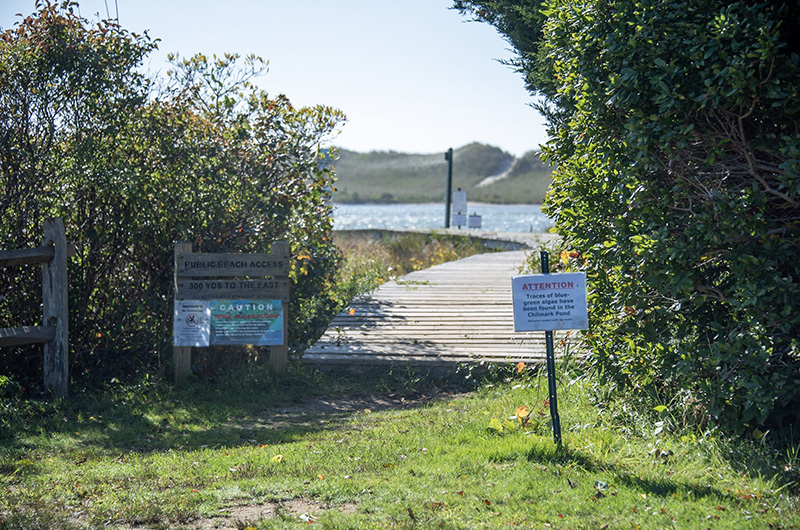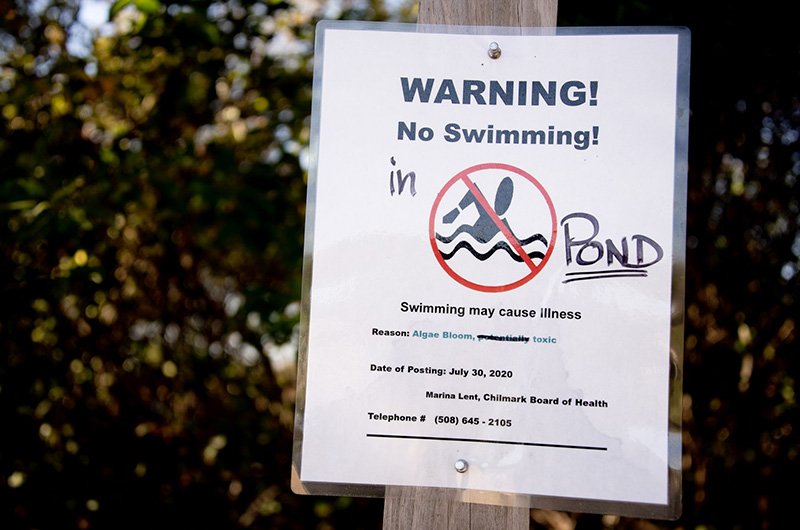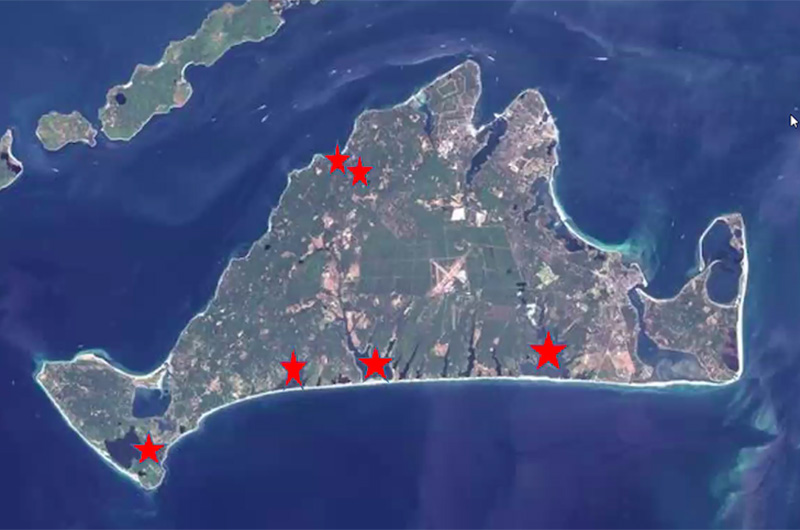Preliminary sampling and analysis from researchers with the University of New Hampshire have revealed high levels of dangerous toxins from cyanobacteria — informally known as pond scum — in many of the Island’s freshwater, brackish and saltwater ponds, prompting concern among Island health and water quality experts and a push for further bacteria testing next season.
The sampling was done in 11 Island ponds earlier this month by Martha’s Vineyard Commission water resource manager Sheri Caseau, after a man was likely sickened in Chilmark Pond and blooms were observed earlier this summer. The samples were sent off to the UNH Center for Freshwater Biology for analysis. Scientists involved in the study include biologists Nancy Leland, associate faculty at the university, and professor Jim Haney.

Bloom-forming cyanobacteria — a type of toxic blue-green algae — were found in six of the sample sites, the scientists revealed in a Zoom call Thursday, including Chilmark Pond, Squibnocket Pond, Tisbury Great Pond and Seth’s Pond. A different type of cyanobacteria associated with a dangerous neurotoxin called BMAA was also found in startlingly high quantities in Wintucket Cove off the Edgartown Great Pond, Jobs Neck, James Pond and Chilmark Pond near Abel’s Hill.
“When Nancy showed me her data, I didn’t fall off my chair because I was standing,” Dr. Haney said. “I might have otherwise.”
In the Zoom call, Dr. Haney added that the highest level of BMAA that his lab had ever previously observed was in a heavily polluted lake in northern Massachusetts, with toxin levels of about 25 micrograms per liter. Four of the Island sample sites — including Jobs Neck, sites along the Edgartown Great Pond and James Pond in West Tisbury — were well above that, measuring in the 25 to 40 micrograms per liter range.
“That makes me worried,” Dr. Haney said. “Because one of the things we are not seeing otherwise is the evidence of pollution in your systems that we might expect to see.”
Although links between BMAA —which stands for Methylamino-l-alanine — on various neurodegenerative disorders remains the subject of scientific inquiry, studies have tied it to an increased prevalence of ALS-type symptoms and other related diseases in communities. The toxin became well-known about a decade ago after a study in Guam linked BMAA to neurodegenerative diseases.
Overall, the samples showed that the Island’s freshwater and brackish ponds had comparable levels of other cyanotoxins to ponds on Cape Cod, scientists said, but that the level of BMAA in the Island’s high salinity ponds were particularly troubling — and much higher than those on the Cape.
“What we observed is that for the microcystins [a different cyanotoxin] you are generally in line with what we saw in the Cape,” Ms. Leland said. “For your freshwater sites, similar to what we saw on the Cape. And it looks like, for your higher salinity sites, they are much higher.”
The Zoom conference included the UNH faculty, as well as Ms. Caseau, about 30 Island residents, conservationists, health officials and biologists. Ms. Caseau said that a written version of the results would be made available soon, and that a recording of the presentation would be made available to the public as well.
Earlier this year, a 48-year-old man was likely poisoned by toxins from a cyanobacteria bloom while crabbing in Chilmark Pond, exhibiting a wide variety of “disturbing” physical and neurological symptoms, including swollen feet, disorientation and prolonged fatigue, according to town public health officials and his mother, Carol Forgione.
In an interview with the Gazette this week, Ms. Forgione said that her son, who is six feet, three inches tall, came home after noticing a “glow” in the water. She said he was extremely fatigued, not thinking clearly, incoherent and irritable, as well as swollen throughout his body.
Her son is now about “90 per cent” recovered, Ms. Forgione said, but she added that symptoms persisted for more than a month and said he could not work normally for at least five weeks. She said he was interviewed by a public health official from the Cape who called the symptoms a classic case of cyanobacteria poisoning.
“This made a big person very sick,” Ms. Forgione said. “It’s dangerous.”
Chilmark town administrator Tim Carroll and health agent Marina Lent also said during a selectmen’s meeting that a dog died last year from drinking water near an algae bloom in Chilmark Pond.
Although the presence of cyanobacteria — a toxic form of blue-green algae that can bloom on ponds under specific conditions and creates a beautiful, phosphorescent glow — has been documented previously in Island ponds and occurs in waters throughout the region, with officials posting signs warning residents about blooms, the data collected this September both surprised and alarmed biologists, who indicated they had never seen comparable rates of BMAA, especially in high-salinity ponds.
“We were very surprised by the results,” Dr. Leland said. “I don’t know whether we opened Pandora’s Box, but this certainly is data we have not seen before.”
Dr. Haney said that he had spent many Novembers on Martha’s Vineyard and was also surprised by the results.
“It’s sort of unexpected,” he said. “Looking at the water you wouldn’t have guessed it would have fallen into this category.”
He said surface blooms posed the greatest threat to humans and animals because they concentrated an entire pond of toxins into what is often a few square meters. A little more than a teaspoon of ingested toxic cyanobacteria would be enough to kill a dog, he said.
The testing lab uses a complicated mixture of microscope analysis and a process called fluorometry to analyze samples for the presence of the four known types of cyanobacteria. Because each type of bacteria is associated with certain types of toxins, the presence of one can key researchers to look for the other. Results from the Island sampling suggested that a cyanobacteria called dolichospermum, which can create the toxin anatoxin-A, was a genus of concern for the Vineyard’s freshwater ponds. It was also particularly prevalent in Squibnocket Pond.
Samples also showed very high levels of picocyanobacteria in the Island’s high-salinity ponds, which is associated with the toxin BMAA. While cyanobacteria generally forms the phosphorescent blooms seen in Chilmark Pond and can affect humans through skin contact, picocyanobacteria can spread through the air and affect the food chain, including shellfish.
After sharing the results, Dr. Leland suggested that the Island begin a more comprehensive citizen-science cyanobacteria testing program. She said certain factors could be used to predict the presence and timing of blooms with regular testing sites.
At a commission meeting last week, Ms. Caseau expressed concern about the presence of cyanobacteria in the Island ponds, saying that ecological conditions such as low rainfall and hot temperatures would lead to more frequent algae blooms in the future.
On Thursday, Ms. Caseau said the commission was pursuing a grant to allow for further training and testing in every Island pond, hoping to use the former state lobster hatchery on the Oak Bluffs side of Lagoon Pond as an analysis laboratory. The facility is currently leased by the Martha’s Vineyard Shellfish Group.
“It was really interesting that we found something in all of our waters, and I’d really like to expand that, get a baseline, and see where we go from there,” Ms. Caseau said. “Very scary consequences for us too. We need to get a handle on this better.”








Comments (10)
Comments
Comment policy »